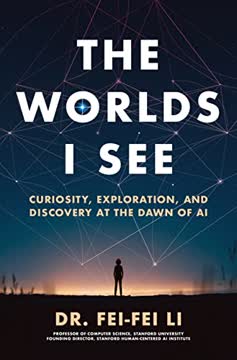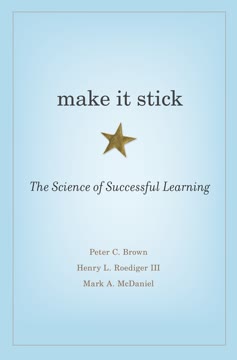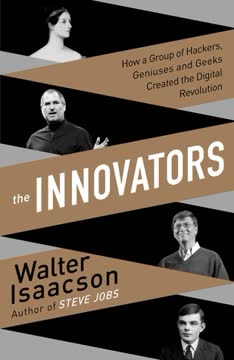Key Takeaways
1. Technology alone cannot transform education
Schools are complex institutions negotiated by a diverse set of stakeholders: teachers, students, families, communities, school boards, trustees, vendors, state and federal governments, and others.
Complex ecosystems. Education systems are intricate webs of stakeholders, each with their own goals and priorities. This complexity makes it difficult for any single technological innovation to create sweeping changes. Schools serve multiple purposes beyond just academic instruction, including socialization, providing meals, and supporting working parents.
Resistance to change. The conservative nature of educational institutions often leads to new technologies being adapted to fit existing practices rather than fundamentally altering them. This "domestication" of technology means that even promising innovations may have limited impact when introduced into real-world educational settings.
Reasons for resistance:
- Entrenched practices and beliefs
- Limited resources for implementation
- Concerns about equity and access
- Skepticism from educators and parents
2. Three genres of learning at scale: Instructor-guided, algorithm-guided, and peer-guided
If we can situate a new technology in its history, we can make predictions about how that new technology will function when integrated into the complex ecology of schools.
Historical context matters. By understanding the lineage of educational technologies, we can better predict their potential impact and limitations. Each genre of learning at scale has its own strengths and weaknesses, which become apparent when examined through a historical lens.
Comparative analysis. Instructor-guided systems like MOOCs rely on traditional lecture-based pedagogy, while algorithm-guided systems like adaptive tutors use data to personalize learning paths. Peer-guided systems, exemplified by platforms like Scratch, emphasize collaboration and creativity. Each approach has found success in specific niches:
- Instructor-guided: Effective for motivated adult learners in professional fields
- Algorithm-guided: Shows promise in subjects like math and early reading
- Peer-guided: Fosters creativity and engagement, especially in informal learning contexts
3. The curse of the familiar: New technologies often reinforce existing practices
Technologies that look like typical elements in schools—like the practice problems on Khan Academy—scale much more easily than things that look very different from anything that has come before, like the open-ended programming environment on Scratch.
Familiarity breeds adoption. Educational technologies that closely resemble traditional teaching methods are more likely to be widely adopted. However, this familiarity often means that these tools do little to fundamentally change educational practices.
Innovation vs. integration. Truly innovative approaches that diverge significantly from established norms face greater resistance in schools. This creates a dilemma for edtech developers:
Easy adoption path:
- Digitize existing practices (e.g., online worksheets)
- Minimal disruption to current teaching methods
- Limited potential for transformative change
Challenging innovation path:
- Introduce novel learning experiences
- Requires significant changes in teaching and assessment
- Higher potential for meaningful impact, but harder to implement at scale
4. The edtech Matthew effect: Technology tends to benefit the already advantaged
New resources—even free, online resources—are more likely to benefit already affluent learners with access to networked technology and access to networks of people who know how to take advantage of free online resources.
Widening gaps. Despite hopes that technology would democratize education, research consistently shows that educational technologies often exacerbate existing inequalities. This "Matthew effect" in edtech means that those with more resources and prior educational advantages tend to benefit more from new tools and platforms.
Multifaceted barriers. The digital divide is not just about access to devices or internet connections. Social and cultural factors play a significant role in determining who benefits from educational technologies:
Technical barriers:
- Lack of reliable internet access
- Outdated devices or software
Social and cultural barriers:
- Limited familiarity with technology
- Lack of support networks for troubleshooting
- Cultural mismatch between tech design and user needs
Educational barriers:
- Varying levels of digital literacy
- Differing expectations for technology use in schools
5. The trap of routine assessment: Autograders limit the scope of what can be evaluated
Computers can only assess what computers themselves can do, so that's what we teach students. But in our economies and labor markets, we increasingly do not need people to do what computers are already good at.
Misaligned incentives. The limitations of automated assessment tools create a paradox in education technology. Autograders excel at evaluating routine tasks, precisely the kind of work that is increasingly automated in the modern economy. This mismatch can lead to a focus on teaching and assessing skills that may be less relevant in the future job market.
Creativity vs. computation. The challenge lies in developing technologies that can assess more complex, open-ended forms of thinking and problem-solving. Current limitations:
Easily assessed by computers:
- Multiple-choice questions
- Basic mathematical calculations
- Simple programming tasks
Difficult to assess automatically:
- Critical thinking and analysis
- Creative writing and argumentation
- Complex problem-solving
- Collaborative skills
6. The toxic power of data and experiments: Balancing research benefits with privacy risks
The toxic power of data and experiments highlights that even if questions about edtech's possibilities and potential are technical in nature, the questions of what we should do with technology are irreducibly political.
Ethical considerations. The vast amounts of data generated by educational technologies offer unprecedented opportunities for research and personalization. However, this data collection also raises serious concerns about student privacy, consent, and the potential misuse of information.
Balancing act. Educators and policymakers must navigate the tension between leveraging data for improvement and protecting student rights. Key considerations:
Benefits of educational data:
- Personalized learning experiences
- Early identification of struggling students
- Evidence-based policy decisions
Risks and challenges:
- Data breaches and unauthorized access
- Algorithmic bias in decision-making
- Long-term consequences of digital profiles
- Erosion of student autonomy and privacy
7. Tinkering towards improvement: Incremental changes over dramatic transformations
If the energy and excitement generated by new technologies could be applied not just to technology, but to technology and system change combined, that would provide the best possible chance for the field of learning at scale to meaningfully improve how people learn in schools and beyond.
Realistic expectations. Rather than expecting revolutionary changes, a more productive approach to educational technology involves making incremental improvements over time. This "tinkering" mindset acknowledges the complexity of educational systems and the need for sustained, multifaceted efforts to create meaningful change.
Holistic approach. Successful implementation of educational technologies requires attention to various interconnected factors:
Technology design:
- User-friendly interfaces
- Alignment with pedagogical goals
- Flexibility for different contexts
Professional development:
- Training for educators on effective integration
- Ongoing support and troubleshooting
Systemic changes:
- Curriculum alignment
- Assessment practices
- School schedules and structures
Community engagement:
- Involving stakeholders in decision-making
- Addressing concerns about equity and access
By focusing on gradual improvements and considering the broader educational ecosystem, we can work towards realizing the potential of technology to enhance learning while avoiding the pitfalls of overhyped "disruptive" solutions.
Last updated:
FAQ
1. What is Failure to Disrupt: Why Technology Alone Can’t Transform Education by Justin Reich about?
- Critical examination of edtech: The book analyzes why technology alone has not revolutionized education, focusing on the persistent gap between edtech promises and real-world outcomes.
- Complexity of education systems: Reich argues that educational change is shaped by social, cultural, and institutional factors, making simple technological solutions insufficient.
- Genres of learning at scale: The book categorizes large-scale learning technologies into instructor-guided, algorithm-guided, and peer-guided models, exploring their strengths and limitations.
- Equity and systemic change: Reich emphasizes that technology often reproduces or worsens inequalities unless integrated with thoughtful, systemic reforms.
2. Why should educators, policymakers, and technologists read Failure to Disrupt by Justin Reich?
- Debunking edtech myths: The book provides a research-based critique of common misconceptions, helping readers avoid repeating past mistakes in educational technology.
- Guidance for realistic implementation: Reich offers a "tinkerer’s guide" for incremental, evidence-based improvements rather than expecting disruptive transformation.
- Equity and ethical focus: The book highlights the importance of designing technology with equity, privacy, and ethical considerations at the forefront.
- Practical design principles: Reich and Mizuko Ito propose actionable principles for developing edtech that serves diverse learners and communities.
3. What are the key takeaways and future directions from Failure to Disrupt by Justin Reich?
- Incremental change over disruption: Reich stresses that meaningful educational improvement comes from long-term, collaborative tinkering, not sudden technological revolutions.
- Integration with human systems: Technology must be thoughtfully embedded within complex educational ecologies, considering teachers, students, and institutions.
- Equity and community engagement: Addressing digital divides and cultural relevance is essential; technology alone cannot democratize education.
- Ethical data use: Responsible stewardship of student data and transparent research practices are critical for building trust and maximizing benefits.
4. What are the three genres of learning at scale described in Failure to Disrupt by Justin Reich?
- Instructor-guided learning: Includes MOOCs and online courses where instructors sequence content and assessments, effective mainly for self-regulated learners in structured domains.
- Algorithm-guided learning: Uses adaptive tutors and computer-assisted instruction to personalize learning paths, excelling in routine, structured tasks like math and early reading.
- Peer-guided learning: Emphasizes community, collaboration, and creativity through platforms like Scratch and connectivist MOOCs, supporting social learning but challenging to integrate into formal education.
- Distinct pedagogical models: Each genre has unique strengths, limitations, and challenges for scaling and equity.
5. How does Justin Reich in Failure to Disrupt explain why technology alone fails to transform education?
- Conservatism of schools: Schools are durable institutions where new technologies are often absorbed into existing practices rather than driving transformation.
- Complexity and multiple stakeholders: Education involves conflicting purposes and diverse actors, making rapid, tech-driven change difficult.
- Need for human support: Effective technology integration requires professional development, peer networks, and systemic backing.
- Domestication of innovation: Technologies are often adapted to fit familiar routines, limiting their transformative potential.
6. What is the "curse of the familiar" in education technology, according to Failure to Disrupt?
- Definition and analogy: The curse of the familiar refers to the tendency for new technologies to mimic traditional classroom practices, making them easy to adopt but unlikely to drive significant improvement.
- Skeuomorphism in edtech: Like digital tools that resemble their analog counterparts, education technologies often replicate worksheets or lectures, stifling innovation.
- Barrier to transformation: Truly novel technologies can confuse or overwhelm educators and learners, slowing adoption and limiting impact.
- Balancing act: Successful innovation requires finding a middle ground between familiarity and new possibilities.
7. What is the "edtech Matthew effect" and how does it impact educational equity in Failure to Disrupt?
- Definition of the effect: The edtech Matthew effect describes how new educational technologies disproportionately benefit already-advantaged learners, widening existing inequalities.
- Evidence from research: Affluent students use technology for creative, higher-order tasks, while marginalized students often have limited access and use tech for rote learning.
- Implications for democratization: Free or open technologies do not automatically level the playing field; social, cultural, and infrastructural barriers must be addressed.
- Design for equity: Reich and Ito propose four design principles to guide equitable edtech development, focusing on shared purpose, support alignment, relevance, and targeted measurement.
8. How does Failure to Disrupt critique the promises of disruptive innovation in education technology?
- Disruptive innovation theory challenged: Reich argues that education systems tend to domesticate new technologies, integrating them into existing routines rather than enabling radical change.
- Historical perspective: The book traces a century of failed predictions, from motion pictures to MOOCs, showing that educational change is incremental and complex.
- Skepticism of grand claims: Reich encourages stakeholders to be wary of hype and focus on realistic, evidence-based improvements.
- Community over heroism: Systemic change requires collaborative efforts among educators, researchers, and designers, not lone inventors.
9. What is the "trap of routine assessment" in education technology, as discussed in Failure to Disrupt?
- Definition of the trap: Computers can only reliably assess routine, structured tasks, leading educational technologies to focus on what machines can grade.
- Misalignment with workforce needs: As routine tasks are automated in the labor market, education risks overemphasizing computational skills at the expense of complex communication and problem-solving.
- Attempts to escape: Advances like automated essay scoring and stealth assessment show promise but remain limited and incremental.
- Human judgment required: Meaningful assessment of complex skills still depends on human evaluators, constraining the reach of automated systems.
10. How does Failure to Disrupt evaluate the impact of MOOCs, adaptive tutors, and peer-guided learning?
- MOOCs: Initially hyped as disruptive, MOOCs mainly serve already-educated, affluent learners and have been absorbed as supplements or online program managers, with low completion rates.
- Adaptive tutors: Systems like ASSISTments and Cognitive Tutor show modest positive effects in math, especially when implemented with fidelity, but are limited to domains suited for autograding.
- Peer-guided learning: Platforms like Scratch foster creativity and engagement through community, but measuring effectiveness is complex and integration into formal schooling is challenging.
- Limited transformative impact: None of these models alone have fundamentally transformed education; success depends on thoughtful integration and support.
11. What are some successful learning technologies or programs highlighted in Failure to Disrupt by Justin Reich?
- ASSISTments and Cognitive Tutors: These adaptive systems have demonstrated positive effects on math learning, especially for struggling students, by supporting personalized instruction.
- Scratch programming community: Scratch has engaged millions of young learners worldwide, promoting creativity and computational thinking through peer-guided learning.
- MOOC-based master’s programs: Georgia Tech’s online master’s in computer science is cited as a scalable, effective model for serving working professionals.
- Equity-focused initiatives: Programs like Tech Goes Home and Family Creative Learning address access, cultural relevance, and targeted support for marginalized learners.
12. What are the best quotes from Failure to Disrupt by Justin Reich and what do they mean?
- “People who do stuff do more stuff, and people who do stuff do better than people who don’t do stuff.” Reich’s Law highlights that engagement correlates with success, but cautions against simplistic interpretations of learning analytics.
- “The trap of routine assessment is that computers can only assess what computers themselves can do, so that’s what we teach students.” This quote encapsulates the risk of narrowing education to what machines can grade, potentially neglecting vital human skills.
- “Educational technology is implicated in perpetuating inequality.” Reich warns that without intentional design and policy, edtech often reinforces existing disparities.
- “We need villages, not heroes.” This phrase summarizes the book’s call for collaborative, community-driven educational change rather than reliance on individual innovators.
Review Summary
Failure to Disrupt: Why Technology Alone Can't Transform Education receives mostly positive reviews, with readers praising its well-researched and balanced approach to educational technology. Many appreciate Reich's critical analysis of edtech hype and his insights into why technology has failed to revolutionize education. Readers find the book informative, thought-provoking, and relevant, especially in light of recent pandemic-driven online learning experiences. Some criticize the book for being too pessimistic or lacking in proposals for improvement, but overall, it's considered a valuable read for those interested in education and technology.
Similar Books










Download PDF
Download EPUB
.epub digital book format is ideal for reading ebooks on phones, tablets, and e-readers.




